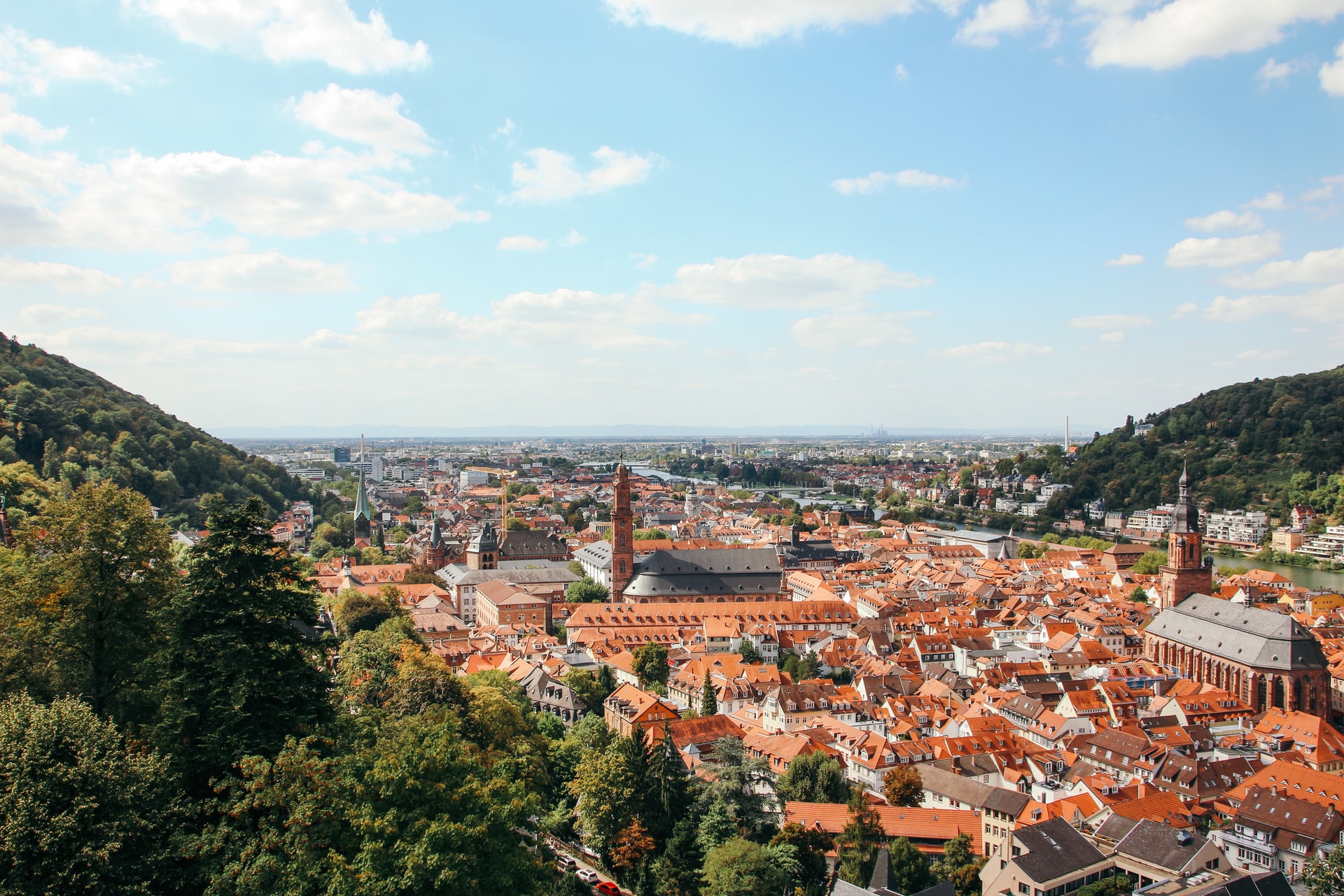
One of the first questions you might have about learning German is how to say German articles, “the” , “a” and “an”.
But, the choices are a little more complicated in German. Instead of two options, you have 11: der, die, das, den, dem, des, ein, eine, einen, einem, and eines.
However, you shouldn't let these articles intimidate you. Because there are plenty of guidelines that can help you choose right.
Like most other aspects of the German language, there are several systematic ways to learn the different articles. And you're going to discover them in this post!
By the way, if you want to learn German fast and have fun, my top recommendation is German Uncovered which teaches you through StoryLearning®.
If you’re ready to get started, click here for a 7-day FREE trial.
What Are Articles?

So articles are words like “a,” “an,” and “the”. These short articles precede nouns that can be people, places, or things.
Articles are simple in English. However, in German, you have over a dozen article options to choose from!
How To Pick The Right Article Declension
Fortunately, German articles can tell you a lot more information about a sentence. And there are many effective ways of remembering which one to use when.
For example, German articles can reveal more about the noun:
- Number – Articles in German can tell you if a noun is singular or plural.
- Gender – German articles indicate the gender of the noun they precede.
- Case – You can also tell which words are the subject, direct object, and indirect object. Using the right articles, you'll have the flexibility to change the word order without changing the meaning! In English, we don't have this luxury. Because we have to stick to a specific sentence structure to make sense.
So this guide will teach you how to use German articles correctly and boost your fluency.
Definite vs. Indefinite Articles In German

There are two general categories of articles:
- Definite Articles – In English, we use the word “the” to talk about a specific person, idea, or object. The three main definite articles in German are der, die, and das.
- Indefinite Articles – The words “a” and “an” allow us to speak about more generic people, places, or objects. In German, words like ein and eine are the equivalent.
Using the right definite and indefinite articles in German is often considered one of the most challenging aspects of learning the language.
But, all you really need is patience, practice. And the willingness to learn.
The German Definite Articles
In German, definite articles change according to their gender, case, and number. But we'll dive deeper into how to determine the gender of nouns and assign the correct articles later.
For now, let's see what the options are:
| Case/Gender | Masculine | Feminine | Neuter | Plural |
| Nominative | der | die | das | die |
| Accusative | den | die | das | die |
| Dative | dem | der | dem | den |
Above, you'll see the three primary definite articles der, die, and das. The word “die” is also used in the plural form. In addition to gender, definite articles also have a case: nominative, accusative, or dative. If you haven't already, learn more about The German Case System.
So let's look at a few simple examples of definite articles in sentences:
- Der Mann heißt Heinrich. (The man is named Heinrich.)
- Die Frau liest mir das Buch. (The woman reads the book to me.)
- Das Kind gibt dem Lehrer den Apfel. (The child gives the teacher the apple.)
Next, let's look at what happens to adjectives used between definite articles and their nouns.
Definite Article Adjective Endings
In addition, if you want to add an adjective between the definite article and a noun, you'll need to add an appropriate German adjective ending.
| Adjective Endings | Masculine | Feminine | Neuter | Plural |
| Nominative | -e | -e | -e | -en |
| Accusative | -en | -e | -e | -en |
| Dative | -en | -en | -en | -en |
In the table above, you'll see the adjective ending is always ‘e' for feminine and neuter nouns in the nominative and accusative cases.
The plural ending for adjectives following definite articles is ‘en'. But masculine words have an ‘e' ending in the nominative case. And an ‘en' ending in the accusative and dative cases.
Next let's add some adjectives to the previous example sentences so we can see how adjective endings work:
- Der kleine Mann heißt Heinrich. (The small man is named Heinrich.)
- Die nette Frau liest mir das Buch. (The nice woman reads the book to me.)
- Das kleine Kind gibt dem neuen Lehrer den frischen Apfel. (The young child gives the new teacher the fresh apple.)
In the first example, der Mann is masculine. And the subject uses the nominative with an e ending. In the next example, die Frau is a feminine noun in the nominative case, which is why you need an ‘e' ending once again.
Similarly, das Kind is a neuter noun in the nominative. And also takes an ‘e' ending. Dem Lehrer is the indirect object receiving an object, which takes the dative case and an en ending. Den Apfel is the direct object, which takes the accusative case and an en ending.
The German Indefinite Articles
Similarly, indefinite German articles also change according to gender and case.
| Case/Gender | Masculine | Feminine | Neuter |
| Nominative | ein | eine | ein |
| Accusative | einen | eine | ein |
| Dative | einem | einer | einem |
So let's plug those indefinite articles into sentences:
- Ich sehe einen Mann. (I see a man.)
- Wir treffen eine Frau. (We are meeting a woman.)
- Er hat ein Kind. (He has a child.)
All of the examples above are in the accusative case. However, each noun takes the form that corresponds to its gender.
Indefinite Article Adjective Endings
In a similar vein to definite articles, if you want to use an adjective after an article and before the noun, the adjective will need an ending.
| Adjective Endings | Masculine | Feminine | Neuter |
| Nominative | -er | -e | -es |
| Accusative | -en | -e | -es |
| Dative | -en | -en | -en |
Notice that the feminine and neuter forms don't change in the nominative or accusative, only in the dative case. But masculine articles change the most.
- Ich sehe einen alten Mann. (I see an old man.)
- Wir treffen eine reiche Frau in einem hohen Schloss. (We are meeting a rich woman in a tall castle.)
- Er hat ein zweites Kind mit einer anderen Frau. (He has a second child with another woman.)
In the first sentence, einen Mann is in the accusative case. And our adjective alt (old) takes an en ending. Next, eine Frau, also in the accusative case, requires an ‘e' ending for its adjective reich (rich). Finally, both the second and third examples end with prepositional phrases in the dative case.
German Articles Have Genders

All German nouns have one of three genders: masculine, feminine, and neuter, and require the corresponding articles.
But, how can you learn which words have which gender?
While some noun genders have to be memorized, you can identify others by various letter combinations.
Firstly, some German noun genders are biologically determined.
- Masculine – Der Mann (the man), der Vater (the father), der Student (the male student), der Lehrer (the male teacher), der Mitarbeiter (the male employee), etc.
- Feminine – Die Frau (the woman), die Mutter (the mother), die Studentin (the female student), die Lehrerin (the female teacher), die Mitarbeiterin (the female employee), etc.
- Neuter – Das Baby (the baby), das Kind (the child), das Haus (the house)
Secondly, most occupational names have both masculine and feminine versions, depending on the gender of the person. In contrast, other German nouns follow grammatical gender patterns.
Note that in English, we refer to objects as “it.” But in German, you use a pronoun that corresponds with the noun's gender, er, sie, or es.

How To Know The Gender Of German Articles

Although not all German nouns follow a gender rule, some letter combinations and other guidelines can help you choose the right gender 9 times out of 10.
- Firstly, over 65% of one-syllable words in German are masculine.
- Secondly, some suffixes are almost always masculine, like ant, er, and or.
- Thirdly, endings such as heit, keit, and ung are feminine.
- And finally neuter endings include chen, lein, um, and o.
So, when you learn new German words, you also need to learn the gender. Then, you'll need the gender to add the right endings to several other words in a sentence. Luckily, there are specific clues that often indicate a noun's gender.
Now, let's look at these hints in more detail to decide whether we need to use der, die, or das.
Masculine Nouns And The Article der
Firstly, below are the suffixes that tend to indicate the masculine gender (der):
- ant – Diamant (diamond), Elefant (elephant), Praktikant (intern)
- ent – Student (student), Patient (patient), Assistent (assistant), Dozent (professor)
- er – Fahrer (driver), Maler (painter), Spieler (player)
- ich – Teppich (carpet), Rettich (radish)
- ismus – Kapitalismus (capitalism), Tourismus (tourism), Alkoholismus (alcoholism)
- ist – Kapitalist (capitalist), Tourist (tourist), Kommunist (communist)
- ling – Zwilling (twin), Frühling (spring)
- or – Autor (author), Diktator (dictator),
In addition, other masculine nouns include:
- Seasons – der Sommer (the summer), der Herbst (the fall), der Winter (the winter)
- Months – der Januar (January), der Februar (February), der März (March)
- Days – der Montag (Monday), der Dienstag (Tuesday), der Mittwoch (Wednesday)
- Map and compass directions – der Norden (north), der Suden (south), der Westen (west), der Osten (east)
- Cars and trains – der BMW, der Volkswagen, der Mercedes
- Many currencies – der Euro, der Dollar, der Cent
- Most mountains or lakes – der Mount Everest, der Mississippi, der Montblanc
Learning the categories and typical endings of words that tend to have a specific noun gender can make the learning process much more manageable.
Also, German occupations can have either a masculine or feminine form. The masculine form usually ends in er or or.
Examples: der Lehrer (the male teacher), der Professor (the male professor), der Fotograf (the male photographer), der Kellner (the male waiter)
Feminine Nouns And The Article die
Secondly, below are the tell-tale suffixes of feminine nouns (die):
- e – Blume (flower), Summe (sum), Katze (cat)
- ei – Polizei (police), Datei (data), Konditorei (confectionary)
- heit – Freiheit (freedom), Gesundheit (health), Sicherheit (security)
- ie – Garantie (guarantee), Fantasie (fantasy), Ökonomie (economy)
- ik – Grammatik (grammar), Mathematik (math), Musik (music)
- ion – Nation (nation), Funktion (function), Produktion (production)
- ität – Nationalität (nationality), Autorität (authority), Spontaneität (sponteneity)
- keit – Aufmerksamkeit (attention), Schwierigkeit (difficulty)
- schaft – Freundschaft (friendship), Landschaft (landscape), Gemeinschaft (community)
- ung – Erfahrung (experience), Empfehlung (recommendation), Zeitung (newspaper)
- ur – Natur (nature), Kultur (culture), Agentur (agency)
Other feminine nouns also include:
- Names of flowers – die Rose (rose), die Tulpe (tulip)
- Names of trees – die Kiefer (pine), die Buche (beech), die Eiche (oak)
- Most fruits – die Birne (pear), die Zitrone (lemon), die Melone (melon)
- Cardinal numbers – die Eins (one), die Zwei (two), die Drei (three)
In addition, feminine occupations add the ending –in.
Examples: die Lehrerin (the female teacher), die Professorin (the female professor), die Fotografin (the female photographer), die Kellnerin (the waitress)
Neuter Nouns And The Article das
Finally, the endings below usually indicate neuter (das) nouns.
- chen – Mädchen (girl), Häuschen (little house),
- lein – Häuslein (little house), Mäuslein (little mouse), Fräulein (young woman)
- ma – Thema (topic), Drama (drama), Schema (diagram)
- ment – Moment (moment), Dokument (document), Experiment (experiment)
- nis – Geheimnis (secret), Gefängnis (jail), Kenntnis (knowledge)
- tel – Hotel (hotel), Viertel (quarter)
- tum – Eigentum (property), Königtum (kingdom), Christentum (christianity)
- um – Aquarium (aquarium), Museum (museum)
However, it's important to note that there are exceptions to the rules.
Examples: die Firma (company), der Reichtum (wealth), der Irrtum (mistake), der Zement (cement)
Compound Noun Genders

In addition, many words in German combine multiple nouns into a new word.
For example:
- die Baustelle (construction site)
- der Fahrplan (the timetable)
- das Kinderbuch (children's book)
In most cases, the last word of the compound noun determines the gender. But, as usual, there are a few exceptions to the rule.
- der Teil (part) – Some compound nouns with Teil take neuter articles: das Gegenteil (opposite), das Einzelteil (individual part), das Abteil (compartment), das Oberteil (top piece), das Ersatzteil (replacement part), das Urteil (verdict).
- der Mut (courage) – Many compound nouns containing Mut take feminine articles: die Armut (poverty), die Wehmut (sorrow), die Demut (humility), die Anmut (grace), die Großmut (generosity), die Langmut (patience).
Also, there are many other exceptions to the noun gender rules. But using the guidelines when in doubt will work 80% of the time.
Plural German Articles

Let's take a moment next to understand how plural articles work in German. Plural nouns always use the article die in the nominative and accusative cases.
- das Mädchen (the girl) – die Mädchen (the girls)
- der Junge (the boy) – die Jungs/Jungen (the boys)
- der Mann (the man) – die Männer (the men)
But in the dative plural case, die changes to den.
- Ich gab den Mädchen Hausaufgaben. (I gave the girls homework.)
- Wir waren überrascht, von den Jungs zu hören. (We were surprised to hear from the boys.)
- Er war beeindruckt von den Männern und ihrer Arbeit.
When declining adjectives, definite articles' plural ending is ‘en' in the nominative, accusative, and dative cases.
- die amerikanischen Mädchen (the American girls)
- Ich gab den faulen Mädchen Hausaufgaben. (I gave the lazy girls homework.)
Another reason to learn the genders of German words is to know if a noun is in its plural or singular form.
For example, the noun Mädchen (girl) is the same in both the singular and plural. So the only way to determine the sentence's meaning is by examining the articles.
How Case Affects German Articles

To choose the right article declension, you'll need to know the number, case, and gender. So you already learned how number and gender affect articles. But what about the cases?
So let's look at German articles from a slightly different angle to see how they change according to the case.
The Nominative Case
Firstly, the nominative case is used for the subject of a sentence. Notice how the feminine and plural articles are the same.
| Definite/Indefinite Articles | Masculine | Feminine | Neuter | Plural |
| Nominative | der/ein | die/eine | das/ein | die/keine |
For example:
- Der/Ein Student lernt schnell. (The/A student learns fast.)
- Die/Eine Blume ist rot. (The/A flower is red.)
- Das/Ein Thema ist langweilig. (The/A topic is boring.)
All of the sentence subjects above use the nominative case of definite and indefinite articles.
The Accusative Case
Secondly, choose accusative case articles for the direct objects of sentences. The direct object of a sentence is the word receiving an action from the verb.
| Definite/Indefinite Articles | Masculine | Feminine | Neuter | Plural |
| Accusative | den/einen | die/eine | das/ein | die/keine |
Notice that neuter and feminine nouns have the same articles in both the nominative, accusative, and plural. So far, only the masculine form changes: der becomes den and ein becomes einen.
Examples:
- Ich (nominative) kaufe den/einen Tisch (accusative). (I buy the/a table.)
- Ein Fahrer (nominative) liefert die/eine Zeitung (accusative). (A driver delivers the/a newspaper.)
- Meine Mutter (nominative) liest das/ein Buch (accusative). (My mother reads the/a book.)
The Dative Case
Thirdly, in the dative case, the most drastic changes take place. Use the dative for indirect objects of a sentence. Indirect objects are typically the person or thing being affected by the direct object.
| Definite/Indefinite Articles | Masculine | Feminine | Neuter | Plural |
| Dative | dem/einem | der/einer | dem/einem | den/keinen |
Because the masculine and neuter articles are the same in the dative case, they're easier to remember. Meanwhile, the feminine articles change into what appears to be the masculine nominative form.
Examples:
- Der Mann (nominative masculine) gibt den Anzug (accusative masculine) der Reinigung (dative feminine). (The man gives the suit to the dry cleaner.)
- Die Professorin (nominative feminine) gibt dem Student (dative masculine) das Buch (accusative neuter). (The professor gives the student the book.)
Now comes the exciting part. German allows you to mix up the word order, as long as you use the correct articles to indicate the direct and indirect objects.
- Der Mann (nominative masculine) gibt der Reinigung (dative feminine) den Anzug (accusative masculine). (The man gives the suit to the dry cleaner.)
- Die Professorin (nominative feminine) gibt das Buch (accusative neuter) dem Student (dative masculine). (The professor gives the student the book.)
Although the subject typically stays in the first position, you can place the direct and indirect object in either position in the sentence.
Possessive Articles

In English, we show possession by adding an ‘s to a name or person. But, to indicate that something belongs to someone in German, you'll need possessive articles. You'll also need an ‘s‘ or ‘es' ending on the noun's end in the masculine and neuter forms.
| Definite/Indefinite Articles | Masculine | Feminine | Neuter | Plural |
| Possessive | des/eines | der/einer | des/eines | der/keiner |
Once again, the masculine and neuter forms are the same, just as they are in the dative case.
Examples:
- das Fahrrad des Mannes (The man's bicycle)
- die Jacke der Frau. (The woman's jacket)
- das Geheimnis des Hotels. (The hotel's secret.)
Usually, masculine and neuter, one-syllable words add an ‘es' ending while multiple-syllable words add an s ending.
How To Learn German Articles
Below are a few study tips to help you learn the German articles more effectively:
- Firstly, learn nouns and their genders together.
- Secondly, neuter, feminine, and plural articles stay the same in the nominative and accusative cases.
- Thirdly, masculine and neuter, definite and indefinite articles are the same in the dative and possessive cases.
- Finally, the feminine indefinite articles are the same in the dative and possessive cases.
Although learning the German articles does require some memorization of charts, the similarities are simple to recognize.
By creating connections between the articles and their use, you'll learn to select the correct articles with ease.

Final Thoughts
So now you've started to master German articles, it's time to put them into use! Practice makes perfect when it comes to article declensions.
So consider watching German movies or TV series with subtitles to become more familiar with articles.
In addition, reading in German is another fantastic way to start feeling more comfortable with the articles and the general language.
Now, you're all set to speak German with more confidence and accuracy than ever before.
Bis zum nächsten mal! (Until next time)

Olly Richards
Creator of the StoryLearning® Method
Olly Richards is a renowned polyglot and language learning expert with over 15 years of experience teaching millions through his innovative StoryLearning® method. He is the creator of StoryLearning, one of the world's largest language learning blogs with 500,000+ monthly readers.
Olly has authored 30+ language learning books and courses, including the bestselling "Short Stories" series published by Teach Yourself.
When not developing new teaching methods, Richards practices what he preaches—he speaks 8 languages fluently and continues learning new ones through his own methodology.









































